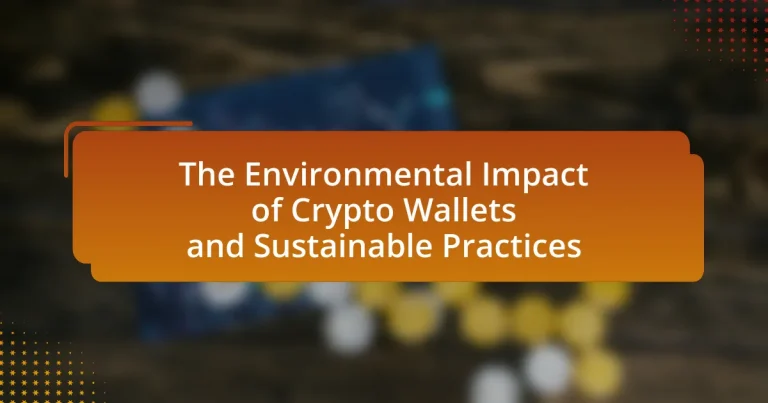The article examines the environmental impact of crypto wallets, emphasizing their connection to the energy-intensive blockchain networks they operate on, particularly those using proof-of-work systems like Bitcoin. While crypto wallets themselves consume minimal energy, the mining processes associated with them lead to significant electricity usage and carbon emissions. The article also explores the materials used in wallet production, their lifecycle impacts, and sustainable practices that can be adopted by users and developers to mitigate environmental harm. Additionally, it discusses future trends in sustainability within the crypto industry and the role of regulatory frameworks in promoting eco-friendly practices.

What is the Environmental Impact of Crypto Wallets?
The environmental impact of crypto wallets is primarily linked to the energy consumption associated with the blockchain networks they operate on. Crypto wallets themselves do not consume significant energy; however, the underlying blockchain technology, particularly proof-of-work systems like Bitcoin, requires substantial computational power, leading to high electricity usage. For instance, the Cambridge Centre for Alternative Finance reported that Bitcoin mining consumes approximately 130 terawatt-hours annually, comparable to the energy consumption of entire countries. This energy demand often results in increased carbon emissions, especially when fossil fuels are the primary energy source. Therefore, while crypto wallets are not directly responsible for environmental harm, their functionality is deeply intertwined with the energy-intensive processes of blockchain networks.
How do crypto wallets contribute to environmental issues?
Crypto wallets contribute to environmental issues primarily through the energy consumption associated with cryptocurrency transactions. The process of validating transactions and maintaining blockchain networks often requires significant computational power, which in turn leads to high electricity usage. For instance, Bitcoin mining, which is closely linked to crypto wallets, consumes approximately 100 terawatt-hours of electricity annually, comparable to the energy consumption of entire countries like the Netherlands. This high energy demand often relies on fossil fuels, resulting in increased carbon emissions and contributing to climate change.
What are the energy consumption levels associated with crypto wallets?
Crypto wallets themselves typically consume minimal energy, primarily when used for transactions or maintaining connections to the blockchain. The energy consumption levels are significantly lower compared to the energy-intensive processes associated with mining cryptocurrencies. For instance, a standard software wallet may use around 0.1 to 1 kilowatt-hour (kWh) per month, depending on usage and device efficiency. In contrast, Bitcoin mining operations can consume upwards of 1000 kWh per transaction. This stark difference highlights that while crypto wallets have a relatively low energy footprint, the broader ecosystem, particularly mining, poses substantial energy consumption challenges.
How does the carbon footprint of crypto wallets compare to traditional banking?
The carbon footprint of crypto wallets is generally higher than that of traditional banking. Research indicates that the energy consumption of cryptocurrency mining and transactions can lead to significant greenhouse gas emissions, with Bitcoin alone estimated to consume around 100 terawatt-hours annually, comparable to the energy usage of entire countries. In contrast, traditional banking systems, while not without their own environmental impacts, typically operate on a much lower energy scale due to established efficiencies in transaction processing and infrastructure. For example, a study by the Cambridge Centre for Alternative Finance highlights that the banking sector’s carbon footprint is significantly lower per transaction compared to that of cryptocurrencies, primarily due to the high energy demands of blockchain technology.
What materials are used in the production of crypto wallets?
Crypto wallets are primarily produced using materials such as plastic, metal, and paper. Plastic is commonly used for hardware wallets due to its durability and lightweight properties. Metal, often in the form of aluminum or stainless steel, is utilized for its strength and resistance to wear, particularly in premium hardware wallets. Paper wallets, which are a form of cold storage, use standard paper but may also incorporate specialized inks or coatings for added security. These materials are chosen based on their ability to protect digital assets while considering factors like cost, security, and environmental impact.
How do these materials affect the environment during production?
The materials used in the production of crypto wallets, particularly electronic components and packaging, significantly affect the environment through resource extraction, energy consumption, and waste generation. The extraction of metals like lithium and cobalt for batteries leads to habitat destruction and pollution, while the manufacturing process consumes substantial energy, often sourced from fossil fuels, contributing to greenhouse gas emissions. For instance, a study by the International Energy Agency indicates that the production of lithium-ion batteries can emit up to 150 kg of CO2 per kWh of battery capacity. Additionally, improper disposal of electronic waste from crypto wallets can result in toxic substances leaching into soil and water, further harming ecosystems.
What is the lifecycle impact of crypto wallets on the environment?
The lifecycle impact of crypto wallets on the environment primarily involves energy consumption and electronic waste generation. Crypto wallets, particularly those associated with cryptocurrency mining and transactions, require significant computational power, leading to high energy usage. For instance, Bitcoin mining alone consumes approximately 100 terawatt-hours annually, which is comparable to the energy consumption of some countries. Additionally, the production and disposal of hardware used for crypto wallets contribute to electronic waste, with millions of devices becoming obsolete each year. This waste often contains hazardous materials that can harm the environment if not properly recycled. Thus, the lifecycle of crypto wallets significantly affects both energy resources and waste management systems.

What sustainable practices can be adopted in the use of crypto wallets?
Sustainable practices that can be adopted in the use of crypto wallets include utilizing energy-efficient hardware, opting for wallets that support eco-friendly cryptocurrencies, and implementing secure backup methods that minimize data redundancy. Energy-efficient hardware reduces the carbon footprint associated with crypto transactions, as traditional mining and transaction processes can be energy-intensive. Choosing wallets that support cryptocurrencies with lower environmental impacts, such as those using proof-of-stake mechanisms, further contributes to sustainability. Additionally, secure backup methods, such as using cloud storage with renewable energy sources, help in reducing the overall environmental impact of data storage associated with crypto wallets.
How can users minimize the environmental impact of their crypto wallets?
Users can minimize the environmental impact of their crypto wallets by choosing wallets that utilize energy-efficient consensus mechanisms, such as proof-of-stake instead of proof-of-work. Proof-of-stake systems require significantly less energy for transaction validation, as they do not rely on energy-intensive mining processes. For example, Ethereum’s transition to proof-of-stake has reduced its energy consumption by approximately 99.95%, according to the Ethereum Foundation. Additionally, users can opt for wallets that support eco-friendly cryptocurrencies, which are designed with sustainability in mind. By making informed choices about the types of wallets and cryptocurrencies they use, individuals can effectively reduce their carbon footprint associated with crypto transactions.
What are the best practices for energy-efficient crypto transactions?
The best practices for energy-efficient crypto transactions include utilizing proof-of-stake (PoS) consensus mechanisms, optimizing transaction batching, and employing energy-efficient hardware. Proof-of-stake significantly reduces energy consumption compared to proof-of-work systems, as it does not require extensive computational power for mining. For instance, Ethereum’s transition to PoS has led to a reduction in energy usage by approximately 99.95%. Transaction batching minimizes the number of individual transactions processed, thereby lowering the overall energy expenditure. Additionally, using energy-efficient hardware, such as ASIC miners designed for lower power consumption, can further enhance energy efficiency in crypto operations. These practices collectively contribute to a more sustainable approach to cryptocurrency transactions.
How can users choose eco-friendly wallet options?
Users can choose eco-friendly wallet options by selecting wallets that utilize sustainable materials and energy-efficient technologies. Eco-friendly wallets often incorporate recycled materials, such as recycled plastics or organic fabrics, which reduce environmental impact. Additionally, users should consider wallets that operate on energy-efficient platforms, minimizing carbon footprints associated with cryptocurrency transactions. Research indicates that digital wallets can significantly lower energy consumption compared to traditional banking systems, making them a more sustainable choice.
What role do developers play in creating sustainable crypto wallets?
Developers play a crucial role in creating sustainable crypto wallets by designing software that minimizes energy consumption and enhances user efficiency. They implement algorithms that optimize transaction processing, reducing the computational power required, which directly lowers the carbon footprint associated with blockchain transactions. For instance, developers can utilize proof-of-stake mechanisms instead of energy-intensive proof-of-work systems, significantly decreasing energy usage. Additionally, they can integrate features that promote eco-friendly practices, such as carbon offsetting options for users. This approach not only addresses environmental concerns but also aligns with the growing demand for sustainable technology solutions in the cryptocurrency space.
How can wallet developers implement green technologies?
Wallet developers can implement green technologies by utilizing energy-efficient algorithms and promoting the use of renewable energy sources for their operations. For instance, adopting proof-of-stake consensus mechanisms instead of energy-intensive proof-of-work can significantly reduce energy consumption. According to a study by the Cambridge Centre for Alternative Finance, proof-of-stake systems can decrease energy usage by up to 99% compared to traditional mining methods. Additionally, wallet developers can partner with green energy providers to ensure that their servers run on renewable energy, further minimizing their carbon footprint.
What are the benefits of open-source wallets in promoting sustainability?
Open-source wallets promote sustainability by enabling transparency, community collaboration, and reduced resource consumption. Transparency allows users to verify the code and ensure that the wallet operates efficiently without unnecessary energy expenditure. Community collaboration fosters the development of features that prioritize eco-friendly practices, such as energy-efficient transaction methods. Additionally, open-source wallets often require less computational power compared to proprietary alternatives, leading to lower energy consumption and a smaller carbon footprint. This aligns with the growing emphasis on sustainable practices within the cryptocurrency ecosystem, as evidenced by initiatives aimed at reducing the environmental impact of blockchain technologies.

What are the future trends in sustainable crypto wallet practices?
Future trends in sustainable crypto wallet practices include the integration of energy-efficient technologies, the use of carbon offsetting mechanisms, and the promotion of decentralized finance (DeFi) solutions that prioritize sustainability. Energy-efficient technologies, such as proof-of-stake consensus mechanisms, significantly reduce the energy consumption associated with transactions compared to traditional proof-of-work systems. For instance, Ethereum’s transition to proof-of-stake has been projected to decrease its energy usage by over 99%. Carbon offsetting mechanisms are increasingly being adopted by wallet providers to neutralize their carbon footprints, with companies like BitGreen leading initiatives to fund renewable energy projects. Additionally, the rise of DeFi platforms encourages the development of eco-friendly financial products, fostering a community that values sustainability in crypto transactions. These trends reflect a growing awareness and commitment to reducing the environmental impact of cryptocurrency operations.
How is the crypto industry evolving towards sustainability?
The crypto industry is evolving towards sustainability by increasingly adopting energy-efficient consensus mechanisms and integrating renewable energy sources into mining operations. For instance, Ethereum transitioned from a proof-of-work to a proof-of-stake model, reducing its energy consumption by approximately 99.95%. Additionally, initiatives like the Crypto Climate Accord aim to accelerate the transition to 100% renewable energy for crypto mining, with over 200 organizations supporting this goal. These developments indicate a significant shift in the industry’s approach to environmental impact, focusing on reducing carbon footprints and promoting sustainable practices.
What innovations are being introduced to reduce the environmental impact?
Innovations being introduced to reduce environmental impact in the context of crypto wallets include the development of energy-efficient consensus mechanisms, such as Proof of Stake (PoS), which significantly lower energy consumption compared to traditional Proof of Work (PoW) systems. For instance, Ethereum’s transition to PoS has reduced its energy usage by approximately 99.95%, demonstrating a substantial decrease in carbon footprint. Additionally, the integration of carbon offset programs within crypto platforms aims to neutralize emissions by investing in renewable energy projects. These innovations collectively contribute to a more sustainable approach in the cryptocurrency sector.
How can regulatory frameworks support sustainable practices in crypto wallets?
Regulatory frameworks can support sustainable practices in crypto wallets by establishing guidelines that promote energy efficiency and environmental responsibility. These frameworks can mandate the use of renewable energy sources for mining operations associated with crypto wallets, thereby reducing carbon footprints. For instance, regulations can incentivize companies to adopt eco-friendly technologies and practices, such as proof-of-stake mechanisms, which consume significantly less energy compared to traditional proof-of-work systems. Additionally, regulatory bodies can implement reporting requirements that compel wallet providers to disclose their energy consumption and sustainability efforts, fostering transparency and accountability in the industry. This approach aligns with global sustainability goals, as evidenced by initiatives like the European Union’s proposed regulations aimed at reducing the environmental impact of digital assets.
What practical steps can users take to support sustainability in crypto wallets?
Users can support sustainability in crypto wallets by choosing wallets that utilize energy-efficient blockchain technologies. For instance, wallets that operate on proof-of-stake networks consume significantly less energy compared to those on proof-of-work systems, which require extensive computational power. Additionally, users can opt for wallets that prioritize carbon offset initiatives, contributing to projects that neutralize their carbon footprint. Research indicates that the energy consumption of Bitcoin mining alone is comparable to that of entire countries, highlighting the importance of selecting sustainable options. By actively engaging with eco-friendly wallets and supporting renewable energy initiatives, users can effectively reduce the environmental impact associated with their cryptocurrency transactions.
What resources are available for users to learn about sustainable crypto practices?
Users can learn about sustainable crypto practices through various resources including online courses, articles, and community forums. Platforms like Coursera and Udemy offer courses specifically focused on sustainable blockchain technologies, while websites such as CoinDesk and CryptoSlate publish articles that discuss the environmental impact of cryptocurrencies and sustainable practices. Additionally, forums like Reddit and specialized Discord channels provide community-driven discussions and insights on sustainable crypto initiatives. These resources collectively enhance understanding and promote responsible practices in the cryptocurrency space.


